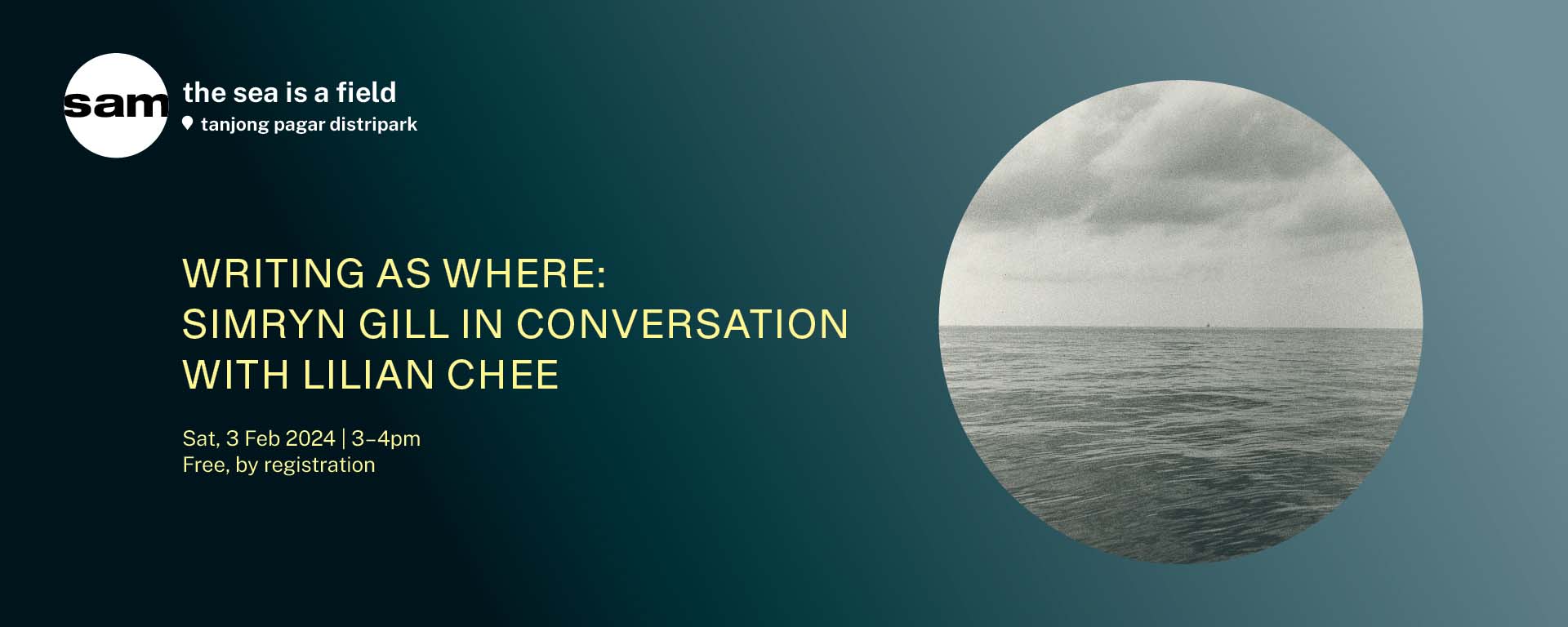Writing as Where: Simryn Gill in Conversation with Lilian Chee
This talk between artist Simryn Gill and NUS Associate Professor of Architectural Theory and Design Lilian Chee considers writing as a mode of encounter. Possessing great immediacy and intimacy, writing gives shape to that which is ephemeral, specific and sometimes unwieldy. 'Writing as where' considers the uses of writing by Gill and Chee in documenting and recording relationships between oneself and the spaces and objects surrounding us.
The conversation will be moderated by SAM curator, Selene Yap and followed by a Q&A session.
About the artist
Simryn Gill (b. 1959, Singapore; lives and works in Port Dickson, Malaysia, and Sydney, Australia) works with a wide range of methods for thinking and making, including writing, drawing, photography, printmaking, creating collections of things, altering objects and publishing. Collecting materials and images from her immediate surroundings, Gill generates poetic and philosophical explorations into the places that we inhabit and carry within us. With Tom Melick, she runs Stolon Press, a publisher in Sydney that makes books and pamphlets, and organises occasional meals and conversations between people working in different modes and practices. Gill has had numerous solo exhibitions in institutions such as Art Gallery of New South Wales (2002, 2022), Tate Modern (2006) and Lund Konsthalle (2017). Gill has also participated in many international exhibitions, including the Singapore Biennale (2006), documenta (2007, 2012), Istanbul Biennial (2011, 2022), Venice Biennale (2013) and Dhaka Art Summit (2018).
About the speaker
Lilian Chee is Associate Professor at the Department of Architecture, National University of Singapore, where she co-leads the Research by Design Cluster. Her research connects embodied experience and affective evidence with architectural representation and feminist politics. Her award-winning film collaboration 03-FLATS (2014) has screened in 16 major cities. She is on the editorial boards of Architectural Theory Review, Australian Feminist Studies, the idea journal and advisor for the Bloomsbury Architecture Library. Her current book projects are Architecture and Affect: Precarious Spaces (Routledge, 2023), and Remote Practices: Architecture at a Distance (Lund Humphries, 2022). She co-directed a documentary Objects for Thriving (2022) which connects objects, domestic spaces, structures of feeling and the elderly. She was visiting Fellow at Future Cities Lab Singapore-ETH Centre (2018) and Honorary Senior Research Associate at Bartlett UCL (2018-2019). Her forthcoming research explores the intersection of home-based work practices with domesticity through an affective-feminist perspective.
The Sea is a Field reveals the inner workings of the collaboration between artists Simryn Gill and Charles Lim Yi Yong as part of the inaugural SAM Fellowship programme. During the pandemic years, they put forth a question that became the basis of this exhibition: How to travel between where they live in Port Dickson, Malaysia, and Singapore by sea? As it turns outs, there is no simple route. In August 2023, the artists and curators took a trip using a network of local ferries that link small port towns across Malaysia, Indonesia, and Singapore. This journey was an opportunity to further their method of working alongside each other, with Lim making observations by video and Gill by photography and writing. Through parallax perspectives, the artists recorded and annotated stories of everyday crossings, migrations, and borders, which connect to a deep cultural and political history of the region. This portside warehouse, left in its raw, near-empty state, becomes a place where their processes of collaboration is exposed. The artists consider this less a finished exhibition space than a site that can hold both of their observations and sensibilities—a zone of convergence for solitary and private undertakings, now made public.
Since the 19th century, the Indian Ocean littoral has come to be submerged under larger global flows of colonialism and nationhood. However, in the last two decades, with the initiation of major infrastructure projects, it has resurfaced as a site for open contestation. Neoliberal expansionism, resource use and geopolitics have dominated recent mappings of the littoral. Today, highly specialised capital, infrastructural, ecological, and migratory flows occupy the sea lanes from Canton to Zanzibar. Despite these ‘newer’ neoliberal algorithms, its peoples have continued to chart their own cultural and aesthetic visions, highlighting a need to discuss how the human agency evolves across this terraqueous terrain. In a series of conversations grounded in contemporary practice, Village of Rafts lays the groundwork for an aspirational network across the Indian Ocean littoral.


